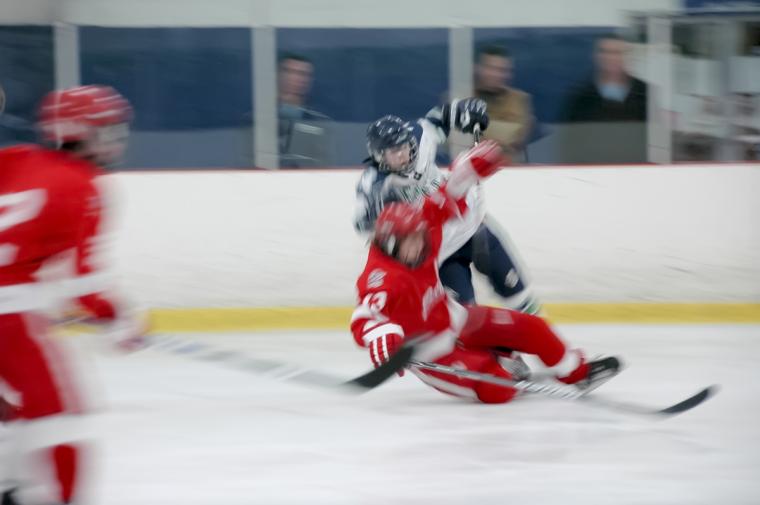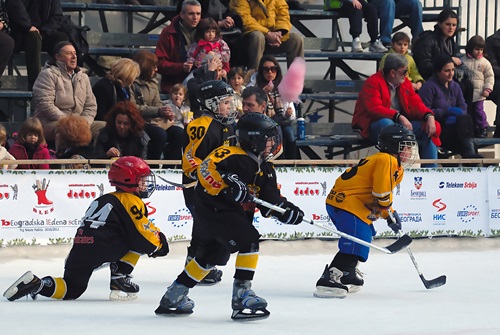
Parents of youth hockey players can rest a little easier, following USA Hockey's announcement that a requirement for neck protection apparel will go into effect.
According to the announcement, the use of neck laceration protection for players in all age classifications, other than adults, in games and practices, as well as for on-ice officials under the age of 18, goes into effect on August 1, 2024. For clarity, the requirement includes players in the youth, girls and junior age classifications.
The move comes as the result of a renewed safety discussion following the October death of former NHL player Adam Johnson, who was playing for a team in England’s Elite Ice Hockey League when a skate blade cut his throat during a collision.
Even in advance of the announcement, youth hockey organizations were leaning heavily on the side of player safety.
“We highly encourage neck guards,” Kory Scoran, head of hockey at Idaho IceWorld — which features two NHL regulation-size rinks in Boise — told KIVITV.com. “We have them in the pro shop in the rink, and so at the younger ages, almost all the kids are wearing them. I think as they get older, a little more aggression comes into the game; there’s checking and stuff like that. But also at the younger ages, there’s a lot more incidental contact that happens when they’re learning to play. So I think it’s important at all ages.”
The new ruling recommends, but does not mandate, the use of neck laceration protection by adult players. (And to say it will be interesting to see where the NHL goes with this... well, that's an understatement.) As noted in a previous article in the SDM Blitz,the NHL does not currently mandate neck protection; The Guardian notes: “But accidents happen [in the NHL] too. In 1989, the Buffalo Sabres goaltender Clint Malarchuk had his throat slashed by a skate during a game against the St Louis Blues after two players crashed his net. He received 300 stitches but returned to the ice within two weeks. In 2008, Richard Zednik’s throat was accidentally cut by a Florida Panther teammate’s errant skate during a game against the Sabres. Zednik recovered but missed the remainder of the season.
In all that time, only two NHL players wore neck coverings of any kind. One was Tomas Plekanec, whose turtleneck earned him ridicule. The other was Wayne Gretzky. In 2020, Moritz Seider, now with the Detroit Red Wings, was playing in Sweden when a neck guard saved him from a potentially horrific skate laceration. Three years later, the NHL defenseman goes without one.
By and large, the NHL and its players have been notoriously slow to adopt safety measures. They eschewed goalie masks for decades, gradually wore helmets only after a 1979 mandate was imposed and glacially adopted (and began abiding by) stricter rules for dangerous hits such as those to the head. This resistance to safety lies partly in the NHL’s history and mindset, which is representative of a broader mentality in the sport, especially in North America. It is proud of the danger inherent in the game.”
For more information, including frequently asked questions on the new policy for youth hockey players, click here.
The NHL’s profile might not be as high among young athletes as, say the National Football League’s. But NHL teams know the future of their franchises depends on strong community relations, and they are scoring big with new and expanded partnerships in their communities.
The New York Islanders — in partnership with Northwell Health, the New York Racing Association and USA Hockey — last month opened The Park at UBS Arena, a 155,800-square-foot outdoor experience that will supply the community’s first two public pond hockey rinks.
 With UBS Arena (home of the Islanders) located in the heart of historic Belmont Park, The Park aims to take advantage of this unique horse-racing setting all NHL season long.
With UBS Arena (home of the Islanders) located in the heart of historic Belmont Park, The Park aims to take advantage of this unique horse-racing setting all NHL season long.
The first rink, named the Northwell Pond, boasts a sheet of natural ice that will host a series of 4-on-4 pond hockey tournaments following USA Hockey guidelines and catering to youth and adult divisions at various competition levels. The second rink, named the Isles Pond and featuring synthetic technology to help ensure season-long use, will host Learn to Skate, Learn to Play and Try Hockey for Free programs that cater to a wide range of age groups and skill levels — aiming to increase interest in the sport.
Public skate sessions also will be offered on both ponds, and Islanders season ticket holders will receive a 25% discount.
Dan Craig, who was facilities operations manager for the NHL for 23 years and oversaw the ice for more than 30 outdoor NHL games, is now overseeing the two ponds at The Park. The Islanders Adult Pond Classic is slated for Jan. 18-21 and Jan. 25-28, while the week-long Islanders Youth Pond Hockey Festival takes place Feb. 17-22.
“So many of us players got our start playing pond hockey,” former Islander Pat LaFontaine said in a statement. “This is the purest form of the sport.”
Meanwhile, the Washington Capitals have partnered this year with Prince George’s County Public Schools (PGCPS) to introduce hockey to more than 93,460 students across the county’s 167 elementary, middle and charter schools through the Capitals Hockey School program. All told, the program will reach more than one million students at schools across more than 20 counties in Maryland, Virginia and Washington, D.C.
As part of the program, the Capitals donate hockey equipment — including sticks, nets, balls and pucks — to each school, and physical education teachers receive a standardized curriculum following SHAPE America’s national requirements. Additionally, the Capitals Youth Hockey Development staff visits schools to host assemblies. The PGCPS programming, which will become a core unit in the county’s P.E. curriculum, is part of the Capitals’ investment of more than $3.5 million toward the development of youth hockey in Maryland, Virginia, and Washington, D.C., and is funded primarily by the National Hockey League’s Industry Growth Fund.
To celebrate the PGCPS announcement, the Capitals hosted a hockey school clinic on Jan. 4 at Capitol Heights Elementary School in Capitol Heights, Md., for third through fifth graders. The clinic introduced them to stickhandling, passing and taking a shot on net.

